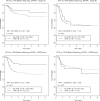Association between contralateral prophylactic mastectomy and breast cancer outcomes by hormone receptor status
- PMID: 22517269
- PMCID: PMC3478501
- DOI: 10.1002/cncr.27574
Association between contralateral prophylactic mastectomy and breast cancer outcomes by hormone receptor status
Abstract
Background: The effect of contralateral prophylactic mastectomy (CPM) on the survival of patients with early-stage breast cancer remains controversial. The objective of this study was to evaluate the benefits of CPM using a propensity scoring approach that reduces selection bias from the nonrandom assignment of patients in observational studies.
Methods: A total of 3889 female patients with stage I to III breast cancer were identified who were treated at The University of Texas MD Anderson Cancer Center from 1997 to 2009. We assessed the association between CPM and disease-free (DFS) and overall survival (OS), by using Cox proportional hazards models to estimate hazard ratios (HRs), and by matching patients in the CPM and no-CPM groups using propensity scores (n = 497 pairs).
Results: With a median follow-up time of 4.5 years, CPM was associated with improved DFS (HR, 0.75; 95% confidence interval [CI], 0.59-0.97) and OS (HR, 0.74; 95% CI, 0.56-0.99), adjusted for prognostic factors. The improved DFS was seen predominantly among hormone receptor-negative (HR, 0.60; 95% CI, 0.38-0.95) compared with hormone receptor-positive patients (HR, 0.80; 95% CI, 0.58-1.10). For the matched patient cohort, stratified survival analysis also showed an improvement in DFS with CPM (HR, 0.48; 95% CI, 0.22-1.01) in hormone receptor-negative patients that was nearly statistically significant.
Conclusions: CPM was associated with improved DFS for some patients with hormone receptor-negative breast cancer, after reducing selection bias. Identifying subsets of patients most likely to benefit from CPM may have important implications for a more personalized approach to treatment decisions about CPM.
Copyright © 2012 American Cancer Society.
Figures

References
-
- Tuttle TM, Habermann EB, Grund EH, Morris TJ, Virnig BA. Increasing use of contralateral prophylactic mastectomy for breast cancer patients: a trend toward more aggressive surgical treatment. J Clin Oncol. 2007;25(33):5203–9. Available from http://www.ncbi.nlm.nih.gov/entrez/query.fcgi?cmd=Retrieve&db=PubMed&dop.... - PubMed
-
- Lostumbo L, Carbine NE, Wallace J. Prophylactic mastectomy for the prevention of breast cancer. Cochrane Database Syst Rev. 2010;10(11):CD002748. Available from http://www.ncbi.nlm.nih.gov/entrez/query.fcgi?cmd=Retrieve&db=PubMed&dop.... - PubMed
-
- Adami HO, Bergstrom R, Hansen J. Age at first primary as a determinant of the incidence of bilateral breast cancer. Cumulative and relative risks in a population-based case-control study. Cancer. 1985;55(3):643–7. Available from http://www.ncbi.nlm.nih.gov/entrez/query.fcgi?cmd=Retrieve&db=PubMed&dop.... - PubMed
-
- Schairer C, Brown LM, Mai PL. Inflammatory breast cancer: high risk of contralateral breast cancer compared to comparably staged non-inflammatory breast cancer. Breast Cancer Res Treat. 2011;129(1):117–24. Available from http://www.ncbi.nlm.nih.gov/entrez/query.fcgi?cmd=Retrieve&db=PubMed&dop.... - PMC - PubMed
-
- Healey EA, Cook EF, Orav EJ, Schnitt SJ, Connolly JL, Harris JR. Contralateral breast cancer: clinical characteristics and impact on prognosis. J Clin Oncol. 1993;11(8):1545–52. Available from http://www.ncbi.nlm.nih.gov/entrez/query.fcgi?cmd=Retrieve&db=PubMed&dop.... - PubMed
Publication types
MeSH terms
Substances
Grants and funding
LinkOut - more resources
Full Text Sources
Medical
Research Materials
Miscellaneous

